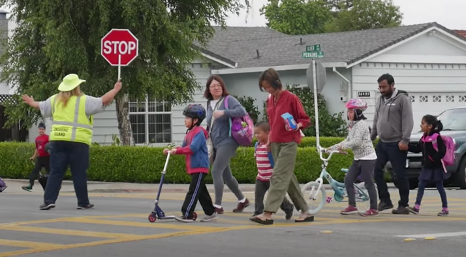Fremont, CA: A community focus on crash reductions pays off
Winner of the 2020 Vision Zero for Youth Leadership Award! View the press release.
Introduction

Fremont, California, stands out as a mid-sized city that has been at the forefront of using the Vision Zero approach to significantly reduce deaths and severe injuries on its roadways. Since the beginning of its program in 2016, Fremont has achieved a 38 percent reduction in crashes involving pedestrians and the city’s focus on children and youth has yielded a 92 percent reduction in crashes among people under age 16. These accomplishments are the reasons why Fremont received the 2020 Vision Zero for Youth Leadership Award. Each year, this award recognizes a city that is leading the way in prioritizing children’s safety while also improving pedestrian and bicyclist safety for all ages.
Fremont is a Silicon Valley city of about 235,000 people and is the fourth most populous city among the 101 cities in the San Francisco Bay Area (following San Jose, San Francisco, and Oakland). In 2015, Fremont was faced with a tremendous concern: vehicle crash numbers trending upwards. City leaders wanted to take action to prevent traffic deaths and injuries. With an estimated 23 percent of the residents of Fremont 18 years old or younger [1], the city decided to include a focus on improving safety specifically for its children and youth.
Crashes before (2013-2015) and after start of Vision Zero Program (2016-2018)
| Major Crashes | Fatal Crashes | Severe Injury Crashes | Major Crashes Involving Pedestrians | Major Crashes Involving Youth Under 16 |
|
|---|---|---|---|---|---|
| 2013-2015 | 104 | 21 | 83 | 34 | 12 |
| 2016-2018 | 68 | 18 | 50 | 21 | 1 |
| % change | -35% | -14% | -40% | -38% | -92% |
In September 2015, the Fremont City Council adopted a Vision Zero policy, and a Vision Zero action plan was subsequently prepared and approved in March 2016, making Fremont the seventh city in the United States to officially adopt a Vision Zero action plan and the first mid-sized city to do so. “We wanted to make a bold statement that traffic deaths are unacceptable and preventable. We wanted to design a system that prioritized people over cars, safety over speed and was data driven,” said Fremont’s Public Works Director Hans Larsen. The program used crash data and local input to inform enforcement, education, and infrastructure improvements including quick build projects.
City and School Partnership
The city and the Fremont Unified School District already had an existing partnership related to a Safe Routes to Schools program, primarily with a focus on school area traffic calming, crossing guards, and occasional encouragement programs like International Walk to School Day. The adoption of Vision Zero, however, inspired the city/school partnership to a new level. At a 2016 quarterly meeting between the city council and school board that included a discussion of Vision Zero, it was agreed that traffic safety assessments should be conducted at all 42 public schools in Fremont with the cost shared by both agencies. What followed was an intense program of school and youth focused safety studies, with 42 plans prepared by a consultant (Alta Planning) in a two-year period, participated in by City Public Works and Police staff, along with school officials and parents. The study process also included the identification of safe walking routes, traffic safety education, and encouragement efforts to increase walking and bicycling to school. Each school received a “walk and roll” map to show recommended routes for walking and bicycling to each school and designated “park and walk” locations to decrease private vehicle traffic at schools to decrease barriers to active travel to school.
Quick Builds, Lasting Outcomes
Fremont’s Vision Zero focus on child safety included implementing 300 low cost safety improvement projects in school zones. These “quick build” projects, based on findings from school site assessments, ranged from speed management countermeasures (such as “paint and plastic” bulb-outs or other lane narrowing measures), curb extensions to reduce crossing distance, and measures to increase visibility on the route to school such as new stop signs or yield markers at crosswalks. Quick build projects get improvements in place much faster than traditional infrastructure projects. Further, “without the site assessments, the school area improvements would be more complaint driven,” said Matt Bomberg, Senior Transportation Engineer for the City of Fremont Department of Public Works. “Doing assessments allowed us to identify all of the things that were most needed.”
Quick-build projects are also cost-effective for the city (estimates ranging from less than $1000 to $5000 in Fremont, depending on the improvement). As an example, Grimmer Elementary School at Delaware Drive and Newport Drive (shown in photos), received improvements including a new all-way stop, high visibility crosswalks, and “paint and plastic” bulb-outs. These improvements shortened crossing distances across Delaware Drive by 30 percent and across Newport Drive by 50 percent. The changes also prevented an ongoing problem with parents parking at crosswalks to drop off children and blocking sight lines of pedestrians.

Grimmer Elementary School (at right in image), before safety improvements. Photo: Google Maps

Grimmer Elementary School after safety improvements. Photo: City of Fremont
The city led the school assessments but first asked the school district for guidance in prioritizing the order of schools assessed. They also knew that with that input came accountability. The city committed to making improvements to each of the assessed schools within one year. “If you’re going to engage the school community it’s important that they see something coming out of it,” remarked Bomberg. The quick timeline was not always easy to adhere to, and required a high level of responsiveness, communication, and flexibility on the part of the City’s Street Maintenance Division, which has risen to the task of implementing all of the quick build projects.
“We’ve gotten more efficient, we have better equipment, and the staff are better trained, allowing us to complete more projects per year. The traffic engineers have been busy, so we get several new projects per week,” said Jason Bonilla, City of Fremont Street Maintenance Supervisor and team leader for the daily operations of the quick build projects. Bonilla also noted that community feedback to the street changes wasn’t initially enthusiastic. These are high-visibility interventions that started many conversations between the community and the city. “We didn’t have a lot of outreach at the start. People didn’t know what was going on. Their attitudes changed once we explained and they saw the project come together. A year later, people know what is going to be coming, and their attitudes are positive from the very beginning.”
Strong Collaboration Inside and Out
A recurring theme of Fremont’s program is a dedication to strong collaboration and clear communication, both internally and externally. Both Jason Bonilla and Matt Bomberg noted the value of strong leadership by the Director of Public Works, Hans Larsen, and the evolved coordination between the traffic engineering team and the street maintenance team. “We meet with the engineering team monthly,” Bonilla said. “For every quick build project, my staff meets with someone from traffic to go through the project.” Bomberg pointed out, “The street maintenance team has been great partners in making the projects better. For example, they know about new materials, especially for low cost projects.”
In addition to this, the city worked to relieve traffic congestion around schools by shifting focus toward active modes of transportation. The Alameda County Safe Routes to School Program was a natural partner for this, coordinating county-wide encouragement for walking and biking to school. “In other cities we can do all the encouragement and education that we want, but if the city isn’t committed to infrastructure improvements then there’s only so much walking and biking that can happen. That’s why I feel that Fremont is really ahead of the game,” said Leslie Lara-Enriquez, the Alameda County Safe Routes to School Program Manager. “Fremont is most successful because it’s not just the city council and school board working together, the staff are working with staff.” Notably, in 2018, an elementary school in Fremont was recognized with the “golden sneaker” award for having the best countywide “walk and roll” program. A video to recognize the accomplishment was prepared by a student intern and posted on YouTube.
Youth also serve as collaborators towards safety improvements. Alameda County Safe Routes to School Program formed a small committee of students who are dedicated to the cause of active transportation to learn civic leadership skills, fundamentals of community organization, and how to lead and execute events at their own schools.

Photo: City of Fremont
The city fosters youth involvement by teaming with its Youth Commission and Summer Youth Service Corps on its “Look for Safety” program. Students paint “Look” stencils in crosswalks to remind pedestrians to look for oncoming vehicles before crossing. This experience gives the opportunity for conversation about traffic safety, gives youth a way to make a tangible contribution towards their community and hopefully leads them to feel a personal connection to safety for their city’s streets.
Addressing Speed
Lowering speeds along arterials and near schools helps reduce crash frequency and severity and is a critical component of the city’s Vision Zero and Safe Routes to School efforts. Public support is critical and Fremont residents generally support lower speeds for increased quality of life.
Law enforcement are important partners in this work as well. The Fremont Police Department conducts targeted enforcement using data driven information. To maximize capabilities, officers were cross trained and patrol officers got additional equipment to support traffic enforcement. The police department also provides timely access to crash data and crash report narratives with Public Works staff. This data is critical in being able to plan and measure the impact of projects over time. This is a real advantage over cities that have to wait until they can access the information from the state.
Fremont has also worked to redesign major arterial roadways to promote slower speeds, including narrowing travel lanes to 10 feet (with excess width allocated to enhanced bike facilities), reducing turning radii to slow turns, and installing 30 new permanent radar feedback signs. The city has conducted new speed surveys on safety priority streets and streets that have been redesigned to determine if posted speed limits can be lowered, in accordance with the state-mandated 85th percentile operating speed rule for setting speed limits. Based on these updated speed surveys, the city has lowered speed limits on nearly 40 street segments citywide.
Make Walking and Biking Safer then Encourage More
 Vison Zero for Youth encourages communities to prioritize the safety of child and youth pedestrians and bicyclists by focusing safety improvements and slowing traffic speeds near schools and other places where they travel on foot or by bike. Fremont’s actions for children and youth and its impressive results embodies the goals of Vision Zero for Youth.
Vison Zero for Youth encourages communities to prioritize the safety of child and youth pedestrians and bicyclists by focusing safety improvements and slowing traffic speeds near schools and other places where they travel on foot or by bike. Fremont’s actions for children and youth and its impressive results embodies the goals of Vision Zero for Youth.
With many safety improvements in place and many students living close enough to walk or bike, the city and its partners are now focusing on increasing the number of students and families who choose to walk or bike instead of using a personal vehicle for the school commute. Fremont understands that the ability of people to safely walk and bicycle is a vital part of what makes communities thrive.
For more information on Fremont’s Vision Zero and Safe Routes to School programs, visit: www.fremont.gov/528/Transportation-Engineering
